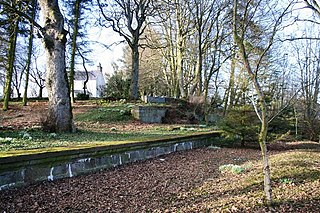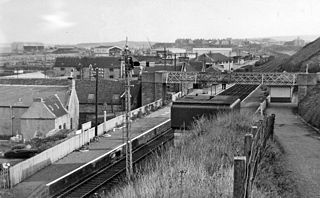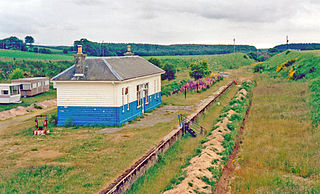Related Research Articles

Aviemore railway station serves the town and tourist resort of Aviemore in the Highlands of Scotland. The station, which is owned by Network Rail (NR) and managed by ScotRail, is on the Highland Main Line, 83 miles 31 chains from Perth, between Kingussie and Carrbridge, and is also the southern terminus of the Strathspey preserved railway.

Dunblane railway station serves the town of Dunblane in central Scotland. It is located on the former Scottish Central Railway, between Stirling and Perth and opened with the line in 1848. It is the northernmost station on the National Rail network to be electrified.

Forres railway station serves the town of Forres, Moray in Scotland. The station is managed and served by ScotRail and is on the Aberdeen–Inverness line, between Nairn and Elgin, measured 119 miles 42 chains (192.4 km) from Perth via the Dava route.
The Buckie and Portessie Branch was a railway branch line in Scotland, built by the Highland Railway to serve an important fishing harbour at Buckie, in Banffshire. It connected with the rival Great North of Scotland Railway at Portessie.

Lethenty railway station was a railway station in Lethenty, Aberdeenshire on the short rural branch line from Inverurie to Old Meldrum serving the rural community of the area.

Alves was a railway station located near Elgin, in the Scottish administrative area of Moray. The station was the junction where the line to Burghead and Hopeman diverged from the line from Aberdeen to Inverness.

Portessie railway station was a joint Highland Railway (HR) and Great North of Scotland Railway (GNoSR) station at the junction between the Moray Coast Railway and the Buckie and Portessie Branch which also served the small fishing village of Portessie, in the parish of Rathven, Scottish county of Moray.

Bromfield was a railway station which served Bromfield, a small settlement in Cumbria on the English side of the Solway Firth. The station opened in 1873 by the Caledonian Railway on a line constructed from the Caledonian Railway Main Line at Kirtlebridge across the Glasgow South Western Line, then forming the Solway Junction Railway over the Solway Viaduct to Brayton. The line opened for freight trains on 13 September 1869.

Buckie railway station was a railway station in Buckie, in current day Moray. The station was opened by the Great North of Scotland Railway (GNoSR) on its Moray Firth coast line in 1886, served by Aberdeen to Elgin trains.

Portgordon railway station was a railway station in Portgordon in Moray, Scotland. The railway station was opened by the Great North of Scotland Railway (GNoSR) on its Moray Firth coast line in 1886, served by Aberdeen to Elgin trains. In 1923 the GNoSR became part of the London and North Eastern Railway (LNER) and at nationalisation in 1948 became part of British Railways. The station was named Port Gordon railway station until 1938 when it was renamed 'Portgordon' by the LNER.

Spey Bay railway station was a railway station in Spey Bay, Moray. The railway station was opened by the Great North of Scotland Railway (GNoSR) on its Moray Firth coast line in 1886, served by Aberdeen to Elgin trains. The station was originally named Fochabers-on-Spey railway station on 1 May 1886. In November 1893 it became Fochabers railway station, Fochabers and Spey Bay railway station on 1 January 1916 before finally becoming on 1 January 1918 Spey Bay railway station. It closed to regular passenger traffic on 6 May 1968 on the same date as the line itself.

Urquhart railway station was a railway station serving the village of Urquhart, parish of Urquhart, Moray. The railway station was opened by the Great North of Scotland Railway (GNoSR) on its Moray Firth coast line in 1884, served by Aberdeen to Elgin trains.

Enzie railway station was a station which served the hamlet of Enzie, in the Scottish county of Moray. It was served by trains on the Buckie and Portessie Branch north of Keith. The latter station is now the nearest to Enzie.

Drybridge Platform railway station or Drybridge railway station was a station which served the hamlet of that name in the parish of Rathven and in addition provided transport for the inhabitants of the Parish of Deskford, Scottish county of Moray. It was served by trains on the Buckie and Portessie Branch north of Keith.
Rathven railway station was a station which served the hamlet of that name, about a mile away in the parish of Rathven, Scottish county of Moray. It was served by trains on the Buckie and Portessie Branch north of Keith.

Buckie railway station was one of two stations which once served the town of Buckie, in the parish of Rathven, Scottish county of Moray. This Highland Railway station was served by trains on the Buckie and Portessie Branch north of Keith until 1915 and remained open for freight until April 1944.
Findochty railway station was a railway station in the small fishing village of Findochty, Moray about 3 miles to the east of Buckie. The railway station was opened by the Great North of Scotland Railway (GNoSR) on its Moray Firth coast line in 1886, served by Aberdeen to Elgin trains.

Glassaugh railway station was a railway station that served the rural area of Glassaugh and the nearby Glenglassaugh distillery close to Portsoy in Moray. The railway station was opened by the Great North of Scotland Railway (GNoSR) on its Moray Firth coast line in 1884, served by Aberdeen to Elgin trains. The station closed to regular passenger traffic on 21 September 1953, more than a decade before the total closure of the line itself in 1968.

Banavie Pier railway station was the terminus of a short branch and was at first known as Banvie, opened by the North British Railway in 1895. The station's location was just above the impressive flight of locks on the Caledonian Canal known as "Neptune's Staircase", Banavie, Highland council area, Scotland.

Tauchers Platform railway station served Glentauchers distillery, Mulben, Moray, Scotland that had originally opened in 1897 and the hamlet of Tauchers. The single platform halt was opened by the London, Midland and Scottish Railway circa 1923 on the Inverness and Aberdeen Junction Railway route for the convenience of workers at the site and for the general public from 1949. The station lay 3 miles 70 chains (6.2 km) from Keith railway station.
References
- ↑ Wilkinson 1988, p. 40.
- 1 2 Wilkinson 1988, p. 49.
- 1 2 3 Wilkinson 1988, p. 31.
- ↑ Wilkinson 1988, p. 77.
- ↑ Wilkinson 1988, p. 26.
- ↑ Wilkinson 1988, p. 54.
- ↑ Wilkinson 1988, p. 55.
- 1 2 Wilkinson 1988, p. 58.
- ↑ Wilkinson 1988, p. 61.
- ↑ Wilkinson 1988, p. 62.
- ↑ Wilkinson 1988, p. 63.
- 1 2 Wilkinson 1988, p. 35.
- ↑ Wilkinson 1988, p. 29.
- ↑ Wilkinson 1988, p. 43.
- ↑ Wilkinson 1988, p. 44.
- ↑ Wilkinson 1988, p. 65.
- Butt, R. V. J. (October 1995). The Directory of Railway Stations: details every public and private passenger station, halt, platform and stopping place, past and present (1st ed.). Sparkford: Patrick Stephens Ltd. ISBN 978-1-85260-508-7. OCLC 60251199. OL 11956311M.
- Jowett, Alan (2000). Jowett's Nationalised Railway Atlas (1st ed.). Penryn, Cornwall: Atlantic Transport Publishers. ISBN 978-0-906899-99-1. OCLC 228266687.
- Jowett, Alan (March 1989). Jowett's Railway Atlas of Great Britain and Ireland: From Pre-Grouping to the Present Day (1st ed.). Sparkford: Patrick Stephens Ltd. ISBN 978-1-85260-086-0. OCLC 22311137.
- Wilkinson, Brian (1988). The Heilan Line. The Portessie Branch of the Highland Railway. Dornoch Press. ISBN 0-9513358-2-0.
- Station on navigable O.S. map station site is near distillery on thin goods line
| Preceding station | Historical railways | Following station | ||
|---|---|---|---|---|
| Keith Junction | Highland Railway Buckie and Portessie Branch | Enzie | ||